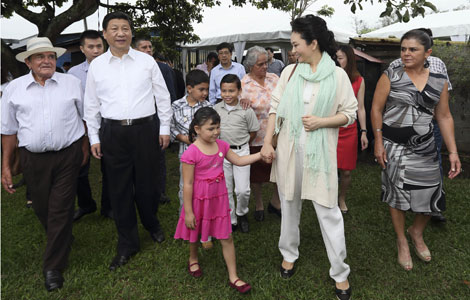Yuan for the international road
Updated: 2013-04-08 07:57
By John McCormick (China Daily)
|
||||||||
Financial crises in the United States and Europe mean the world needs a new, more stable global reserve currency, and rapidly rising trade in renminbi. In the foreign exchange market, for example, RBS Group figures show that the volume of renminbi trade is now about $5-6 billion a day, double of what it was a year ago.
A number of factors suggest that China wants to internationalize its currency by 2015.
First, the International Monetary Fund is reviewing its special drawing rights basket, which uses four key international currencies to supplement member countries' official reserves and bolster liquidity. The deadline for completing that review is 2015.
Based on where the G7 countries are today, we believe there's a very strong chance that China can get the CNY, the onshore version of the renminbi, into that basket, which will be a real boost to the currency on the world stage.
Also, the Shanghai municipal government has set a goal of making the city the global pricing center for both onshore and offshore renminbi financial products by 2015 and a global financial center by 2020. These goals clearly set the blueprint for the internationalization of the renminbi.
Then there are China's efforts alongside that of the United Kingdom to promote London as a CNY center, which would operate in partnership with China's Hong Kong Special Administration Region. Achieving this would make London the first CNY hub outside China and be a big step toward the internationalization of the renminbi.
As part of this, the People's Bank of China (the central bank) could sign a currency swap line with the Bank of England within a year, or two at the most, enabling both banks to exchange a fixed amount of each other's currencies to stabilize their own and improve liquidity. In time, London could even set up its own clearing bank for the CNY.
There are plans to set up another CNY center in Singapore, but the Chinese authorities see this more as a regional hub. They want Hong Kong to partner with London so that they have first-mover advantage in Europe.
Another sign that China is moving to make the renminbi a global reserve currency is that, traditionally, CNH - the offshore version of the renminbi - has traded at a different foreign exchange rate to the CNY because of heavy regulation on the Chinese mainland. But that regulation has now eased and the rates have converged. The turning point of this convergence came when the PBOC widened the intra-day trading band on the onshore CNY exchange rate in April 2012.
China's leaders and the PBOC governor issued statements at the time on allowing the CNY to be traded more freely - a subtle message for a switch from a strong foreign exchange policy to a neutral or even slightly weaker one.
But meeting the government's apparent deadline for the renminbi's internationalization is not going to be easy. The CNY currently ranks 14th as a payment currency globally, with its market share way behind the US dollar and the euro.
The biggest barrier is that CNY is not yet fully convertible, though it is just two steps short of achieving that and three steps away from becoming an international currency.
Those steps involve the authorities to:
first, allow all capital account items to be settled freely in CNY both ways - in and out of China;
second, lift all quotas and streamline the application and approval processes; and
third, increase the use of CNY for international trade and investments.
This is a simplification, of course, because the last step in particular is huge and covers many areas, and the definition of an international currency goes far beyond this description.
Logically, it would be reasonable to expect China to make the CNY fully convertible before embarking on the ultimate goal of internationalizing it. But China appears to have put "the horse before the cart" by creating an offshore market to promote the currency's use in international trade and investment first. As a result, this offshore trade has taken the lead over the onshore market. Again, the authorities clearly have a timeframe in mind.
China's new leadership faces a number of problems. The country's economy is slowing down and, although we would expect the rate of GDP growth to pick up a little, it is unlikely to be a steep rebound. But promoting the renminbi as a global reserve currency, and all the economic benefits it will bring apart from exerting more political influence on the global stage, clearly remains high on their agenda.
The author is CEO, markets & international banking, and chairman, RBS Group, APAC.
Most Viewed
Editor's Picks

|

|

|

|

|

|
Today's Top News
Relationship 'relaunched'
Good start expected for summit
Xi, Mexican president discuss bilateral co-op
Cooperation to drive mutual growth
Chinese president arrives in Mexico for state visit
China is victim of hacking attacks
US to be largest trade partner
China joins fight against hacking
US Weekly

|

|















